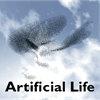Ecology, Spatial Structure, and Selection Pressure Induce Strong Signatures in Phylogenetic Structure
IF 1.5
4区 计算机科学
Q4 COMPUTER SCIENCE, ARTIFICIAL INTELLIGENCE
引用次数: 0
Abstract
Evolutionary dynamics are shaped by a variety of fundamental, generic drivers, including spatial structure, ecology, and selection pressure. These drivers impact the trajectory of evolution and have been hypothesized to influence phylogenetic structure. For instance, they can help explain natural history, steer behavior of contemporary evolving populations, and influence the efficacy of application-oriented evolutionary optimization. Likewise, in inquiry-oriented Artificial Life systems, these drivers constitute key building blocks for open-ended evolution. Here we set out to assess (a) if spatial structure, ecology, and selection pressure leave detectable signatures in phylogenetic structure; (b) the extent, in particular, to which ecology can be detected and discerned in the presence of spatial structure; and (c) the extent to which these phylogenetic signatures generalize across evolutionary systems. To this end, we analyze phylogenies generated by manipulating spatial structure, ecology, and selection pressure within three computational models of varied scope and sophistication. We find that selection pressure, spatial structure, and ecology have characteristic effects on phylogenetic metrics, although these effects are complex and not always intuitive. Signatures have some consistency across systems when using equivalent taxonomic unit definitions (e.g., individual, genotype, species). Furthermore, we find that sufficiently strong ecology can be detected in the presence of spatial structure. We also find that, while low-resolution phylogenetic reconstructions can bias some phylogenetic metrics, high-resolution reconstructions recapitulate them faithfully. Although our results suggest a potential for evolutionary inference of spatial structure, ecology, and selection pressure through phylogenetic analysis, further methods development is needed to distinguish these drivers’ phylometric signatures from each other and to appropriately normalize phylogenetic metrics. With such work, phylogenetic analysis could provide a versatile tool kit with which to study large-scale, evolving populations.生态、空间结构和选择压力诱导系统发育结构的强特征。
进化动力学是由各种基本的、通用的驱动因素形成的,包括空间结构、生态和选择压力。这些驱动因素影响进化轨迹,并被假设影响系统发育结构。例如,它们可以帮助解释自然历史,引导当代进化群体的行为,并影响面向应用的进化优化的有效性。同样,在以探究为导向的人工生命系统中,这些驱动因素构成了开放式进化的关键构建模块。在这里,我们开始评估(a)空间结构、生态和选择压力是否在系统发育结构中留下可检测的特征;(b)特别是在存在空间结构的情况下可以探测和辨别生态的程度;(c)这些系统发育特征在进化系统中普遍化的程度。为此,我们在三种不同范围和复杂程度的计算模型中分析了通过操纵空间结构、生态和选择压力而产生的系统发生。我们发现,选择压力、空间结构和生态对系统发育指标具有特征性的影响,尽管这些影响是复杂的,并不总是直观的。当使用相同的分类单位定义(例如,个体、基因型、物种)时,签名在系统之间具有一定的一致性。此外,我们发现,在空间结构的存在下,可以检测到足够强的生态。我们还发现,虽然低分辨率的系统发育重建可能会影响一些系统发育指标,但高分辨率的重建却忠实地再现了它们。尽管我们的研究结果表明,通过系统发育分析可能对空间结构、生态和选择压力进行进化推断,但需要进一步开发方法来区分这些驱动因素的层学特征,并适当地规范系统发育指标。有了这样的工作,系统发育分析可以提供一个多功能工具包,用于研究大规模的、不断进化的种群。
本文章由计算机程序翻译,如有差异,请以英文原文为准。
求助全文
约1分钟内获得全文
求助全文
来源期刊

Artificial Life
工程技术-计算机:理论方法
CiteScore
4.70
自引率
7.70%
发文量
38
审稿时长
>12 weeks
期刊介绍:
Artificial Life, launched in the fall of 1993, has become the unifying forum for the exchange of scientific information on the study of artificial systems that exhibit the behavioral characteristics of natural living systems, through the synthesis or simulation using computational (software), robotic (hardware), and/or physicochemical (wetware) means. Each issue features cutting-edge research on artificial life that advances the state-of-the-art of our knowledge about various aspects of living systems such as:
Artificial chemistry and the origins of life
Self-assembly, growth, and development
Self-replication and self-repair
Systems and synthetic biology
Perception, cognition, and behavior
Embodiment and enactivism
Collective behaviors of swarms
Evolutionary and ecological dynamics
Open-endedness and creativity
Social organization and cultural evolution
Societal and technological implications
Philosophy and aesthetics
Applications to biology, medicine, business, education, or entertainment.
 求助内容:
求助内容: 应助结果提醒方式:
应助结果提醒方式:


